What is the principle of java reflection mechanism
Java reflection mechanism principle: 1. For any class, you can know all the properties and methods of this class, and for any object, you can call any of its methods; 2. Everything is an object, and classes It is also an object; 3. When [Animal.class] is on the hard disk, it is a file. When loaded into the memory, it can be considered as an object.
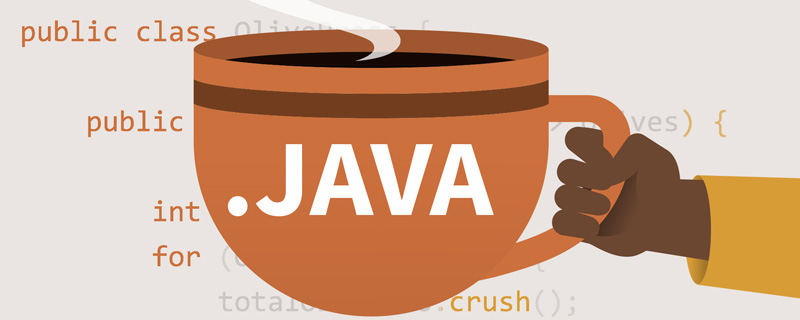
Java reflection mechanism principle:
1. The concept of reflection mechanism:
means that in the running state, for any class, you can know all the properties and methods of this class, and for any object, you can call any of its methods. This kind of dynamic acquisition of information, and dynamic calling of objects The function of the method is called the reflection mechanism of the java language.
2. Application of the reflection mechanism:
Generate dynamic proxy, slice-oriented programming (add before and after calling the method Stack frame).
3. The principle of reflection mechanism:
1. First of all, a clear concept: everything is an object----classes are also objects.
2. Then know the content in the class: modifier constructor field method.
3. Next, understand the loading: When Animal.class is in the hard disk, it is a file. When loaded into the memory, you can It is considered to be an object, an object of java.lang.class.
When running the program, an Animal.class object is generated during instantiation. What is the difference between the two objects?
As shown below , the above Animal.class object is an object of java.lang.class; the following object is an object generated by instantiation of Animal.class
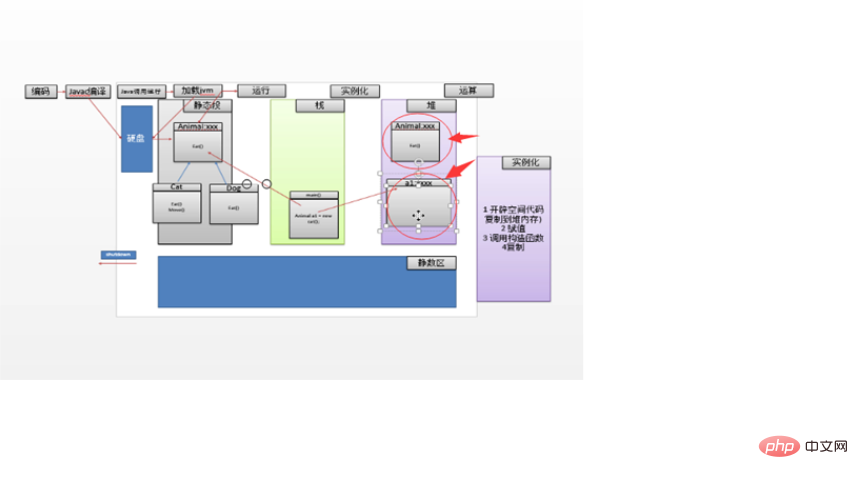
4 . When Animal.class is loaded into the JVM, how does the JVM identify the methods, member variables, construction methods, etc. contained in Animal.class?
As shown below, the member variables in the instantiated object of Animal.class =red;
When loaded into memory, the fur color =null, which is assigned to red when instantiated.

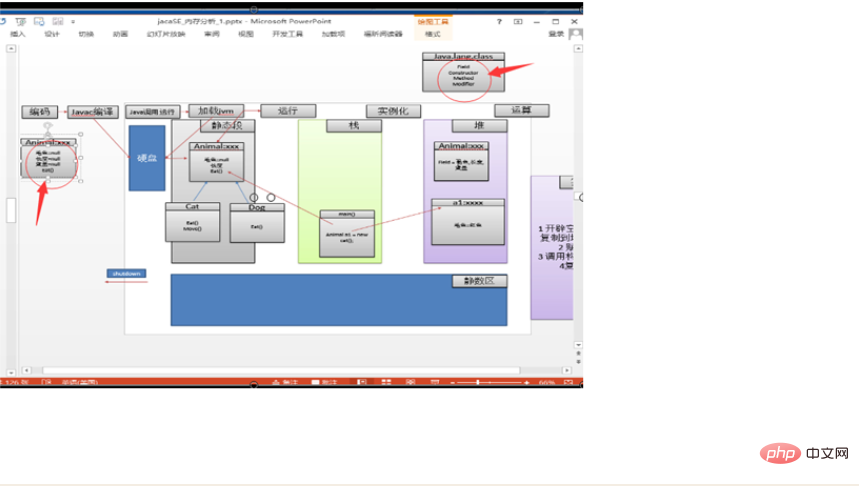
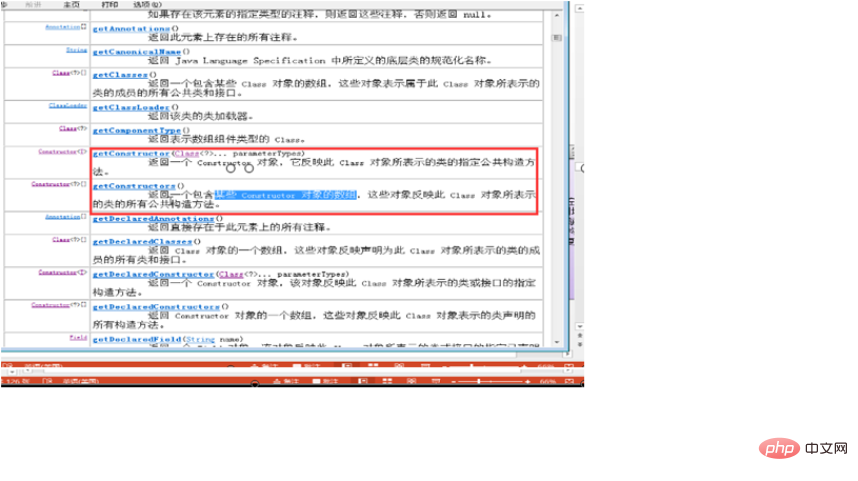
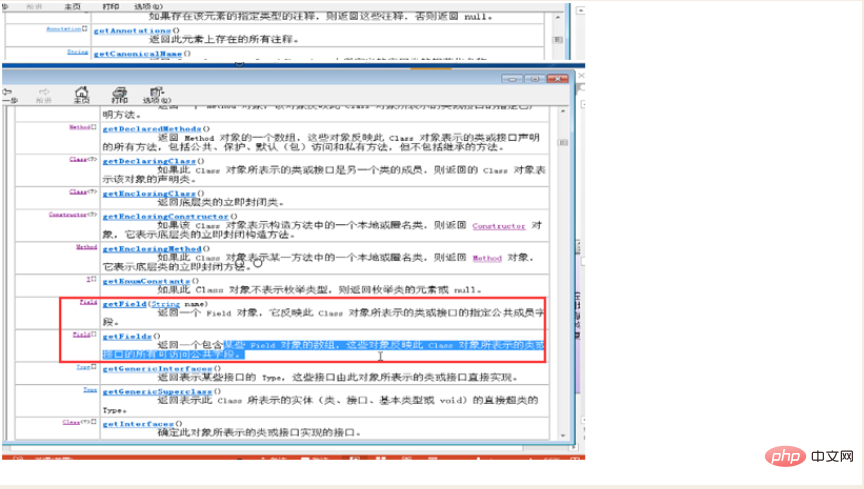 ## in java In .lang.class, coat color is an attribute value of Field. All methods, member variables, constructors, and modifiers in Animal are written according to the standards in java.lang.class, otherwise an error will be reported during compilation.
## in java In .lang.class, coat color is an attribute value of Field. All methods, member variables, constructors, and modifiers in Animal are written according to the standards in java.lang.class, otherwise an error will be reported during compilation.
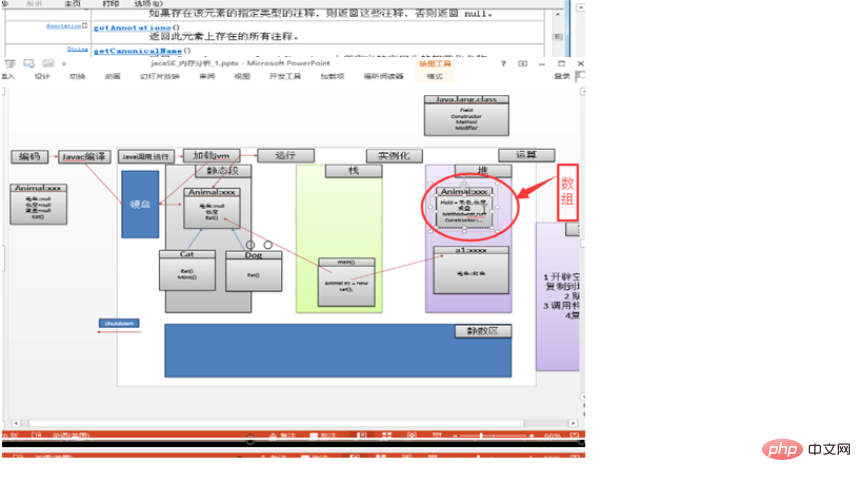 4. Simple example code of radiation mechanism
4. Simple example code of radiation mechanism
public class _14_ReflectTest07
{
public static void main(String[] args) throws Exception{
//1.获取类
Class c = Class.forName("_12_CustomerService");
//获取某个特定的方法
//通过:方法名+形参列表
Method m = c.getDeclaredMethod("login",String.class,String.class);
//通过反射机制执行login方法.
Object o = c.newInstance();
//调用o对象的m方法,传递"admin""123"参数,方法的执行结果是retValue
Object retValue = m.invoke(o, "admin","123");
System.out.println(retValue); //true
}
}
public class _12_CustomerService
{
//登录
public boolean login(String name,String pwd){
if("admin".equals(name) && "123".equals(pwd)){
return true;
}
return false;
}
//退出
public void logout(){
System.out.println("系统已安全退出!");
}
}Related learning recommendations:
The above is the detailed content of What is the principle of java reflection mechanism. For more information, please follow other related articles on the PHP Chinese website!

Hot AI Tools

Undresser.AI Undress
AI-powered app for creating realistic nude photos

AI Clothes Remover
Online AI tool for removing clothes from photos.

Undress AI Tool
Undress images for free

Clothoff.io
AI clothes remover

AI Hentai Generator
Generate AI Hentai for free.

Hot Article

Hot Tools

Notepad++7.3.1
Easy-to-use and free code editor

SublimeText3 Chinese version
Chinese version, very easy to use

Zend Studio 13.0.1
Powerful PHP integrated development environment

Dreamweaver CS6
Visual web development tools

SublimeText3 Mac version
God-level code editing software (SublimeText3)

Hot Topics
 1377
1377
 52
52
 Perfect Number in Java
Aug 30, 2024 pm 04:28 PM
Perfect Number in Java
Aug 30, 2024 pm 04:28 PM
Guide to Perfect Number in Java. Here we discuss the Definition, How to check Perfect number in Java?, examples with code implementation.
 Random Number Generator in Java
Aug 30, 2024 pm 04:27 PM
Random Number Generator in Java
Aug 30, 2024 pm 04:27 PM
Guide to Random Number Generator in Java. Here we discuss Functions in Java with examples and two different Generators with ther examples.
 Weka in Java
Aug 30, 2024 pm 04:28 PM
Weka in Java
Aug 30, 2024 pm 04:28 PM
Guide to Weka in Java. Here we discuss the Introduction, how to use weka java, the type of platform, and advantages with examples.
 Smith Number in Java
Aug 30, 2024 pm 04:28 PM
Smith Number in Java
Aug 30, 2024 pm 04:28 PM
Guide to Smith Number in Java. Here we discuss the Definition, How to check smith number in Java? example with code implementation.
 Java Spring Interview Questions
Aug 30, 2024 pm 04:29 PM
Java Spring Interview Questions
Aug 30, 2024 pm 04:29 PM
In this article, we have kept the most asked Java Spring Interview Questions with their detailed answers. So that you can crack the interview.
 Break or return from Java 8 stream forEach?
Feb 07, 2025 pm 12:09 PM
Break or return from Java 8 stream forEach?
Feb 07, 2025 pm 12:09 PM
Java 8 introduces the Stream API, providing a powerful and expressive way to process data collections. However, a common question when using Stream is: How to break or return from a forEach operation? Traditional loops allow for early interruption or return, but Stream's forEach method does not directly support this method. This article will explain the reasons and explore alternative methods for implementing premature termination in Stream processing systems. Further reading: Java Stream API improvements Understand Stream forEach The forEach method is a terminal operation that performs one operation on each element in the Stream. Its design intention is
 TimeStamp to Date in Java
Aug 30, 2024 pm 04:28 PM
TimeStamp to Date in Java
Aug 30, 2024 pm 04:28 PM
Guide to TimeStamp to Date in Java. Here we also discuss the introduction and how to convert timestamp to date in java along with examples.
 Create the Future: Java Programming for Absolute Beginners
Oct 13, 2024 pm 01:32 PM
Create the Future: Java Programming for Absolute Beginners
Oct 13, 2024 pm 01:32 PM
Java is a popular programming language that can be learned by both beginners and experienced developers. This tutorial starts with basic concepts and progresses through advanced topics. After installing the Java Development Kit, you can practice programming by creating a simple "Hello, World!" program. After you understand the code, use the command prompt to compile and run the program, and "Hello, World!" will be output on the console. Learning Java starts your programming journey, and as your mastery deepens, you can create more complex applications.




